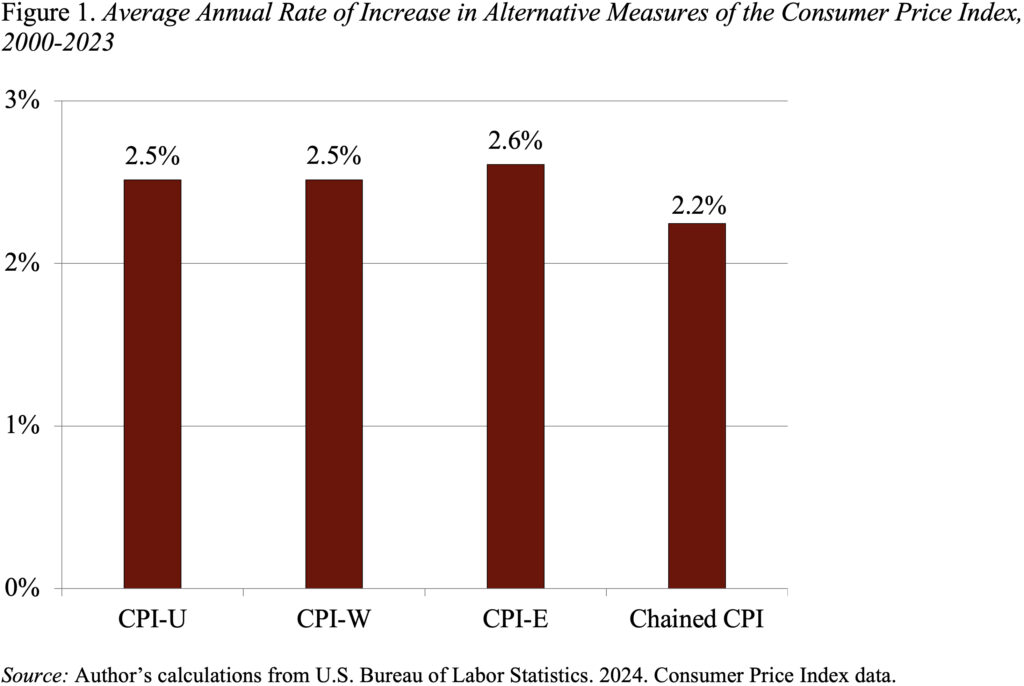The present index is an efficient compromise.
It’s “Social Safety COLA-speculation” season, and with it comes the annual controversy about whether or not the federal government is utilizing the appropriate index to regulate advantages. I might argue that the present index is sweet sufficient; it could actually simply be considered as a compromise between the 2 main alternate options – the CPI-E, which displays the spending of the older inhabitants and rises quicker, and the Chained CPI, which permits for extra substitution and rises extra slowly.
The federal government presently adjusts Social Safety advantages to maintain tempo with the Shopper Value Index for City Wage Earners and Clerical Employees (CPI-W). This index, which covers about 29 % of the inhabitants, was the one one obtainable when the Social Safety COLA was first launched in 1972. In 1978, the Bureau of Labor Statistics expanded the pattern to all city residents and created the CPI-U, which covers about 93 % of the inhabitants, together with most retirees. Regardless of the broader protection and the prominence given the CPI-U within the month-to-month inflation report, the federal government has stayed with the CPI-W for the Social Safety COLA – most probably as a result of the 2 indices observe one another very carefully.
For many years critics have argued that the bundle of products within the CPI-W doesn’t characterize the spending patterns of retirees and due to this fact understates the inflation really skilled by older People. Extra particularly, older folks spend extra on well being care than the younger and well being care costs usually rise quicker than different items, so the CPI-W understates the rise in the price of residing for retirees. In response, in 1988, the BLS launched the CPI-E, which displays the spending patterns of individuals 62 and over.
Economists, then again, argue that the present CPI overstates inflation, as a result of it doesn’t account for a way folks change their shopping for habits in response to a worth enhance. The idea is that by shifting to a detailed substitute services or products, folks can reduce the rise of their value of residing and be simply as completely satisfied. Since January 1999, a geometrical imply method has allowed for modest substitution throughout the 211 merchandise classes (which, mixed with 38 geographic areas, complete 8,018 primary indexes). However it didn’t permit for substitution throughout merchandise classes, resembling pork and beef. The “chained CPI” displays shifts in shopping for patterns that happen when the value of pork rises and the value of beef doesn’t. In 2018, Congress completely switched the inflation adjustment for federal revenue tax provisions to the chained CPI.
Desk 1 reveals how every of those measures of shopper costs have modified between July 2023 and July 2024. As anticipated, the CPI-W and CPI-U are very shut (actually, similar right here), the CPI-E rose quicker, and the chained CPI elevated extra slowly.

The identical sample is obvious when wanting on the similar indices over an extended interval (2000 – the primary yr for which “chained CPI” knowledge can be found – to 2023).

Shifting from the CPI-W to both the CPI-E or the chained CPI would have a noticeable impact on the price of Social Safety advantages over the following 75 years. In calculating these results, this system’s actuaries assume that the CPI-E would enhance the common COLA by 0.2 share factors and that the chained CPI would cut back the common COLA by 0.3 share factors. The projections present that transferring to the CPI-E would enhance the 75-year deficit by 12 %, whereas shifting to the chained CPI would scale back the deficit by 17 %.
One may argue that each the CPI-E and the chained CPI would supply a extra correct measure of the inflation confronted by retirees. Thus, if we have been beginning with a worth index that correctly mirrored the spending patterns of the aged, then transferring to a chained CPI would possibly enhance accuracy. (Though some consultants query whether or not low-income aged reside too near subsistence to alter what they purchase in response to cost modifications.) However on condition that we aren’t beginning with the appropriate measure, the case for switching to a chained CPI is weak. In view of the offsetting results – a 0.3 % overstatement of inflation on account of not accounting for the substitution impact and the projected 0.2 % understatement on account of not reflecting the spending patterns of the aged – the present technique of adjusting advantages appears nearly proper.

